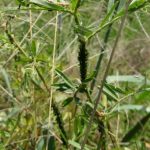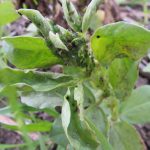History of FBA in Australia
Faba bean aphid (FBA; Megoura crassicauda) originated from East Asia. First recorded in Australia in October 2016 in Sydney, FBA was confirmed in northwest NSW (Tamworth and Breeza) in September 2017. The aphid outbreak was controlled using Aphidex (500 g pirimicarb/kg). FBA was not observed again until 2020, where it was recorded on faba bean and woolly pod vetch (Vicia villosa) in several locations. FBA was also found in 2021 in multiple faba bean sites in northwest NSW including monitoring sites in Glen Innes and Pine Ridge in chickpea and lucerne respectively (although the FBA found in chickpea was likely a reflection of aphid migration, as opposed to aphids landing on the crop). The aphid continued its spread and was recorded in Queensland for the first time in October 2021.
Update on 2022 season
The 2021/22 summer was wetter than average in northern NSW, and the moisture, together with favourable temperatures, supported development of a green bridge that provided shelter and source of food for aphids over summer in the form of volunteers, pasture legumes or weeds growing around or inside cropping areas (e.g., FBA was observed in our monitoring sites in Glen Innes and Moree on volunteer faba beans). Additionally, this winter we have also confirmed outbreaks of FBA on early established faba beans in Tamworth, Coonamble, and Moree.
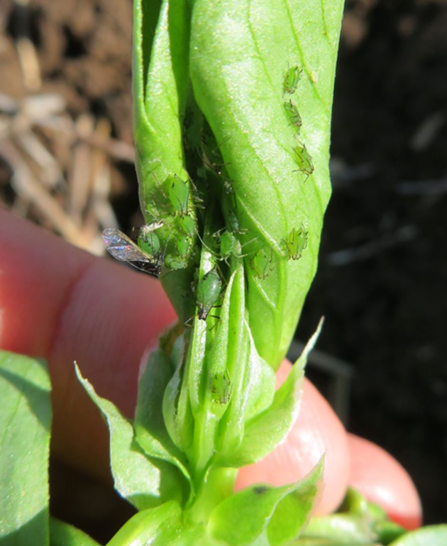
FBA on faba bean seedlings
Host range
Even though FBA has not established throughout all faba bean growing regions in Australia, the detection in early established faba bean crops in north-west NSW means FBA populations have survived and built up over the past six years, likely using alternative hosts such as lucerne and pasture legumes, including woolly pod vetch (Vicia villosa) and volunteer faba bean plants (click on images below for larger version). Comprehensive studies on the host range of FBA have found faba bean to be the primary host plant of the aphid, together with vetch (Duric et al., 2022). High reproduction rates were also recorded on common pea and lentil, and even though subclover and lucerne appeared to be the least favourable hosts, FBA was still able to survive in low numbers on these crops.
- FBA on wooly pod vetch
- FBA on volunteer faba bean
Damage and virus vector potential
FBA colonise plants fast and reproduce intensively. Colonies are often predominantly wingless aphids aggregated in hotspots in the crop. Generally, FBA can be found on plant tips and underside of leaves, but late infestations could affect the whole steam, leaves, and pods. Intensive infestations can cause necrosis, wilting, stunting and defoliation.
NSW DPI have conducted virus transmission studies which have confirmed FBA as vector of both Bean leaf roll mosaic virus (BLRV) and Pea seed-borne mosaic virus (PSbMV). The ability to vector both persistently and non-persistently transmitted viruses enlarges FBA’s potential economic impact.
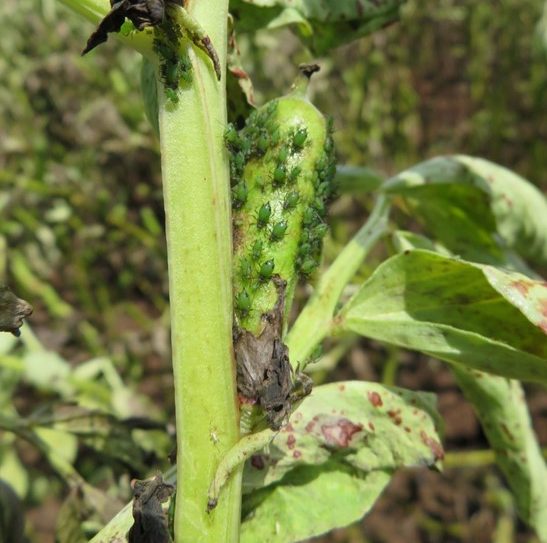
FBA colonies on faba bean pods
How to monitor
Monitoring of FBA is best done in autumn, in early established winter crops, by sampling and observing 20 plants in 5 points across a field. Usually, FBA outbreaks tend to increase from late winter to springtime, therefore, monitor for FBA whenever possible during winter to be ready to prevent aphids from establishing in your crop.
FBA forms colonies in patches, making it easier to spot them on plants. It is a large aphid with body length of more than 3 mm. Adults have a spindle-shaped bright green body with black head, antennae, prothorax, cauda (‘tail’), siphuncles (‘exhaust pipes’) with dark plates at base, and legs, and the antennae exceed the body length. The easiest recognisable character is bright red eyes.
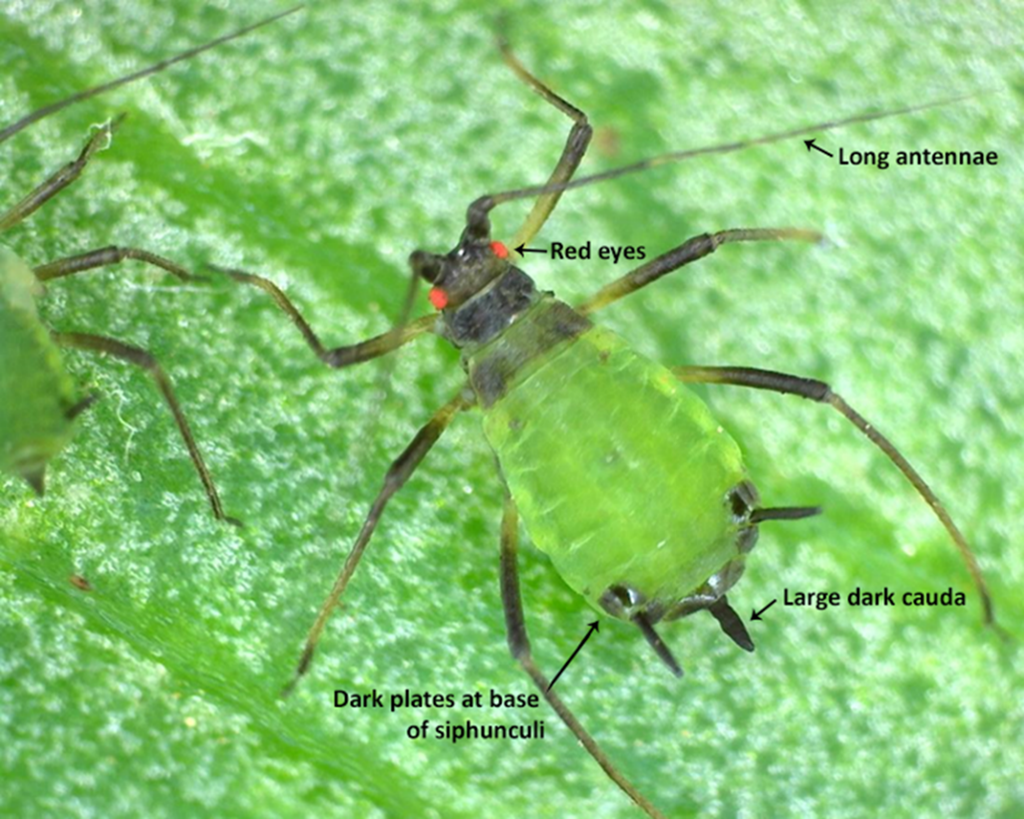
Faba bean aphid adult
Management
Since we are experiencing intensive infestations in faba beans this season, there is a potential threat that FBA will spread further south and become a major problem for faba beans and vetches. Growers are urged to check their crop for presence of FBA and manage any volunteer plants and pasture legumes in their surroundings. Cold weather this winter may suppress their numbers, however the infested paddocks should be managed ASAP. With favourable conditions, FBA could develop large colonies on faba beans in just a few days.
There are no established economic thresholds for FBA. However, Aphidex (500 g pirimicarb/kg) is registered for faba bean and was highly effective in our trials. Most pirimicarb products are limited to two sprays per season at least 14 days apart, therefore, scouting is necessary to effectively target aphids.
References
Duric, Z., George, J. & van Leur, J. 2022: Megoura crassicauda Mordvilko (Hempitera: Aphididae), a potential threat to Faba bean industry in New South Wales, General and Applied Entomology 50: 11-17 (published on-line 17.12.2021)
Hales DF, Gillespie PS, Wade S and Dominiak BC 2017. First detection of Megoura crassicauda Mordvilko (Hemiptera: Aphididae) in Australia and a review of its biology. General and Applied Entomology 45: 77 – 81.

